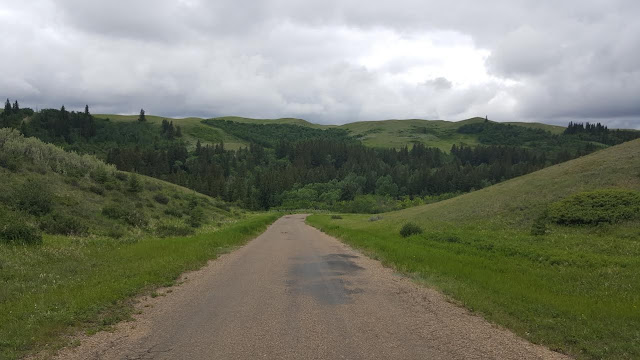On The Road
 |
| Pine Cree Regional Park, Cypress Hills |
After the weather, what people in Saskatchewan talk most about is roads and routes.
Saskatchewan has about
190,000 kilometres of roadway, more than any other province and enough to
circle the planet four times. Most of these roads are in the
southern half of the province, and most of them are gravel — just 13 per cent
are paved. The 647.9-kilometre stretch of the four-lane, divided, blacktopped Trans Canada Highway
between Alberta and Manitoba is the east-west spine, but like most straight
lines, it’s kind of boring. When you detour to the secondary roads, the driving
gets interesting.
 |
| Qu'Appelle Valley |
About 20 years ago, the provincial government began “unpaving” some secondary roads, returning them to gravel because it was cheaper to maintain. Some of that old pavement can be recycled, mixing up to 30% of it with new road surfacing. But even gravel roads are expensive, and getting more so.
In its 2016 report, the Saskatchewan Association of Rural Municipalities (SARM) said the cost of gravel has gone up 300 per cent since the late 1980s. It’s a non-renewable resource, and SARM is actively exploring new sources of the stuff, such as re-mining old gravel pits and even importing gravel from Alberta and BC.
 |
| Grid Road Near Lumsden |
The people of Saskatchewan spend close to a billion dollars a year on roads, but it’s never enough. In addition to highways, Saskatchewan is criss-crossed
by a system of grid roads, linking rural areas with more major
routes. Grid roads are usually gravel, and while they’re graded on a
regular basis, some of the larger rocks could take out your windshield or oil
pan. It’s not hard to see why most people here drive large pickup
trucks. And even those take a beating. This one's only a few years old.
 |
| Manitoba Street, Moose Jaw |
Winter is also hard on
roads. Extreme freeze-thaw cycles heave
the pavement into ridges, potholes, fissures and collapsing shoulders. This week, ice fog covered everything with a treacherous glaze, making even walking an adventure.
 |
| Highway 641 north of Pense |
You rarely see traffic jams in Saskatchewan, though, except maybe at the Tim’s drive-through. And motorists here are among the most courteous in the country. Even so, the province has the highest road fatality rate in Canada.
One traffic choke point is just west of Regina, around the massive and expensive Global Transportation Hub (GTH). Designed to be a multi-modal inland "port" for road and rail, it's only been in operation for a few years - too soon to tell if it's a success. Much to the frustration of almost everyone, the Trans-Canada Highway interchange that serves it is still being built. One thing is clear, though - the GTH is putting a lot more trucks on the road.
On the plus side, gas
is cheap here. Maybe not this
cheap, but substantially cheaper than Vancouver. The price here doesn’t spike just before weekends and
holidays either. In fact it's dropped 14 cents a litre since late September.
Although winter is
still a few weeks away, we’ve already had a few skiffs of snow and temperatures have fallen to minus 21 C a couple of nights. But the real blizzards and brain-freezing
cold are yet to come.
We did learn a new winter
survival trick, though, which we call the Moose Jaw Salute. Lift the wipers off the windshield to keep them from freezing to the glass (and shredding as you peel them off).
But the best tip is, if
you don’t need to go anywhere, then stay home.
Safe travels and happy trails!
 |
| Private bridge, Highway 6 south of Moose Jaw |




Comments
Post a Comment